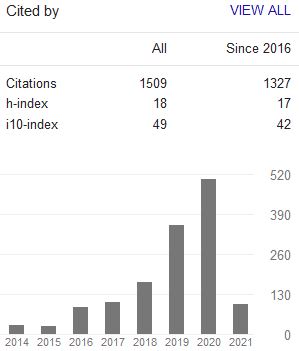THE ROLE OF FAITH-BASED ORGANIZATION IN COPING WITH DISASTER MANAGEMENT AND MITIGATION: Muhammadiyah’s Experience
Abstract
Keywords
Full Text:
PDFReferences
Abdurrahman, Moeslim (ed.). Muhammadiyah sebagai Tenda Kultural. Jakarta: Ideo Press dan Maarif Institute for Culture and Humanity, 2003.
Adeney-Risakotta, B. “Is There a Meaning in Natural Disasters? Constructions of Culture, Religion and Science.” Exchange, 38 (2009): pp. 226-243.
Adhitya, B. et.al. Muhammadiyah dan Kesiapsiagaan Bencana. Jakarta: Risalah MDMC, 2009.
Adiyoso W. and Kanegae, H. “The preliminary study of the role of islamic teaching in the disaster risk reduction; a qualitative case study of Banda Aceh, Indonesia.” Procedia Environmental Sciences 17 (2013 ): 918- 927.
Anderson, M.B., P. Woodrow. “A Framework for Analyzing Capacities and Vulnerabilities.” in Rising from the Ashes, Development Strategies in Times of Disaster. Boulder and San Fancisco: Westview Press, 1989: 9-25.
Berger, J. “Religious Nongovernmental Organizations: An Exploratory Analysis.” Voluntas: International Journal of Voluntary and Nonprofit Organizations. 14/1 (2003): 15-39.
Chester, D.K., AM. Duncan, and C.J.L. Dibben. “The Importance of Religion in Shaping Volcanic Risk Perception in Italy, with Special Reference to Vesuvius and Etna.” Journal of Volcanology and Geothermal Research. 172/3-4 (2008): 216-228.
Chester, D. K. “Theology and Disaster Studies: The Need for Dialogue.” Journal of Volcanology and Geothermal Research. vol. 146, no. 4 (2005): 319-328.
Clarke, M., I Fanany, S. Kenny. Post-disaster Reconstruction: Lessons from Aceh. New York: Earthscan, 2010.
Dove, M. R. “The Panoptic Gaze in a Non-western Setting; Self-surveillance on Merapi Volcano, Central Java.” Religion. 40/2 (2010): 121-127.
Ensor, M. “Disaster Evangelism: Religion as a Catalyst for Change in Post-Mitch Honduras.” International Journal of Mass Emergencies and Disasters. 21, 2 (2003).
Final Report on Muhammadiyah Disaster Management Center for World Vision Indonesia, Sistem Pemulihan Ekonomi Usaha Mikro Korban Erupsi Gunung Merapi Diy-Jateng, Februari 2011.
Gaillard, J. C., and P. Texier. “Religions, Natural Hazards, and Disasters: An Introduction.” Religion. vol. 40, no. 2 (2010): 81-84.
Husein, R. “Muhammadiyah dan Kemanusiaan: Kontribusi MDMC terhadap Penanggulangan Bencana Global.” in Zakiyuddin Baidhawy et.al. Kiprah Pencerahan: Karya Unggulan Muhammadiyah 2005-2015. Jakarta: CDCC, 2015.
http://www.mdmc.or.id/index.php accessed on 1 Juli 2015.
Kuntowijoyo. Paradigma Islam: Interpretasi untuk Aksi. Bandung: Mizan, 1991.
Laporan Pelaksanaan Program Kerja Lembaga Penanggulangan Bencana Pimpinan Pusat Muhammadiyah 2010–2011.
Leurs, R. “Are Faith-based Organisations Distinctive? Comparing Religious and Secular NGOs in Nigeria.” Development in Practice. 22/5-6 (2012): 704-720.
Levy, B.R., M.D. Slade, P. Ranasinghe. “Causal Thinking after a Tsunami Wave: Karma Beliefs, Pessimistic Explanatory Style and Health among Sri Lankan Survivors.” Journal of Religion and Health, 48, 1 (2009): 38-45.
Majelis Tarjih dan Tajdid Pimpinan Pusat Muhammadiyah. Fikih Kebencanaan: Keputusan Musyawarah Nasional Tarjih ke-29 Tahun 2015 di Yogyakarta. Yogyakarta: Majelis Tarjih dan Tajdid PP Muhammadiyah, 2015.
Mercer J., I. Kelman.“Living with Floods in Singas, Papua New Guinea.” in Rajib Shaw, Noralene Uy and Jennifer Baumwool. Indigenous Knowledge for Disaster Risk Reduction: Good Practices and Lessons Learned from Experiences in the Asia-Pacific Region. UNISDR, 2008.
Orji, N. “Faith-Based Aid to People Affected by Conflict.” in Jos. “Nigeria: An Analysis of the Role of Christian and Muslim Organizations.” Journal of Refugee Studies. 24, 3 (2011): 473-492.
Paulson, N., C. Menjívar. “Religion, the State and Disaster Relief in the United States and India.” International Journal of Sociology and Social Policy. vol. 32, no. 3 (2012): 179-196.
Pimpinan Pusat Muhammadiyah. Dakwah Kultural Muhammadiyah. Yogyakarta: PPM, 2003.
Reale, A., “Acts of God(s): the role of religion in Disaster Risk Reduction.” Humanitarian Exchange Magazine. 48 (October 2010), http://www.odihpn.org/humanitarian-exchange-magazine/issue-48/acts-of-gods-the-role-of-religion-in-disaster-risk-reduction, accessed on 23 July 2015.
Rokib, Mohammad. “The Significant Role of Religious Group’s Response to Natural Disasterin Indonesia: the Case of SantriTanggap Bencana(Santana).” Indonesian Journal of Islam and Muslim Societies. vol. 2, no. 1 (June 2012): 53-77.
Schlehe, J. “Anthropology of Religion; Disasters and the Representations of Tradition and Modernity.” Religion, 40/2 (2010): 112-120.
Smith, K. “Risk Assessment and Management.” in Environmental Hazards; Assessing Risk and Reducing Disaster. 4th edition. London: Routledge, 2004: 36-53.
Wisner, B. “Untapped Potential of the World’s Religious Communities for Disaster Reduction in an Age of Accelerated Climate Change; an Epilogue & Prologue.” Religion, vol. 40, no. 2 (2010): 128-131.
DOI: 10.15642/JIIS.2015.9.2.167-194
Refbacks
- There are currently no refbacks.
Indexed by:
Journal of Indonesian Islam (ISSN 1978-6301 and E-ISSN 2355-6994) is published by the Postgraduate Program (PPs) and the Institute for the Study of Religion and Society (LSAS), State Islamic University (UIN) of Sunan Ampel Surabaya.
Journal of Indonesian Islam by http://jiis.uinsby.ac.id/index.php/JIIs/index is licensed under a Creative Commons Attribution-ShareAlike 4.0 International License.
Copyright ©2020 State Islamic University (UIN) of Sunan Ampel Surabaya. Powered by Public Knowledge Project OJS.







